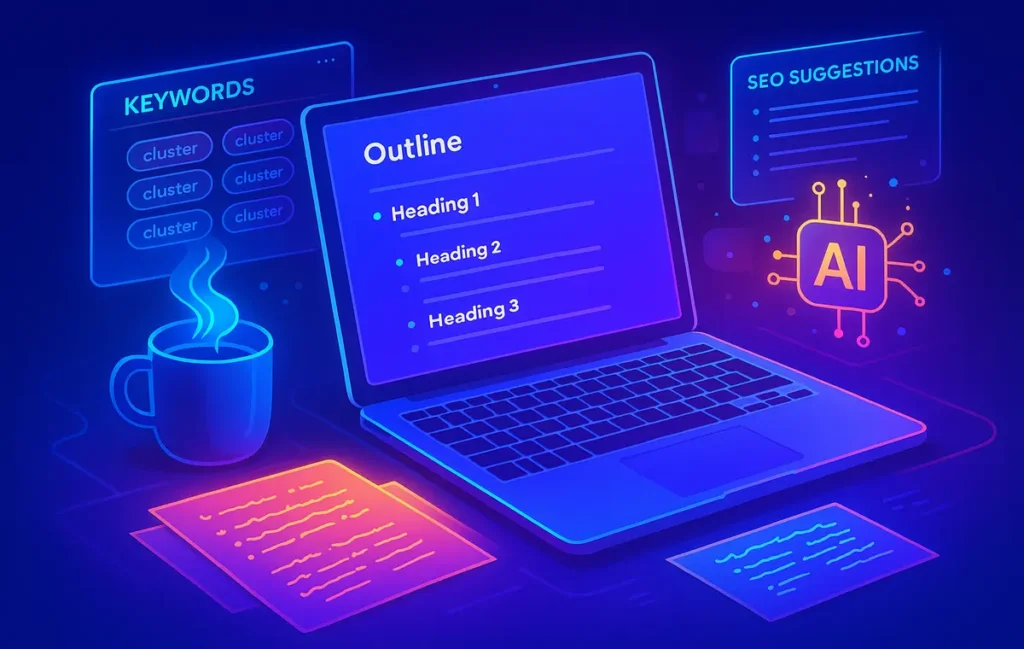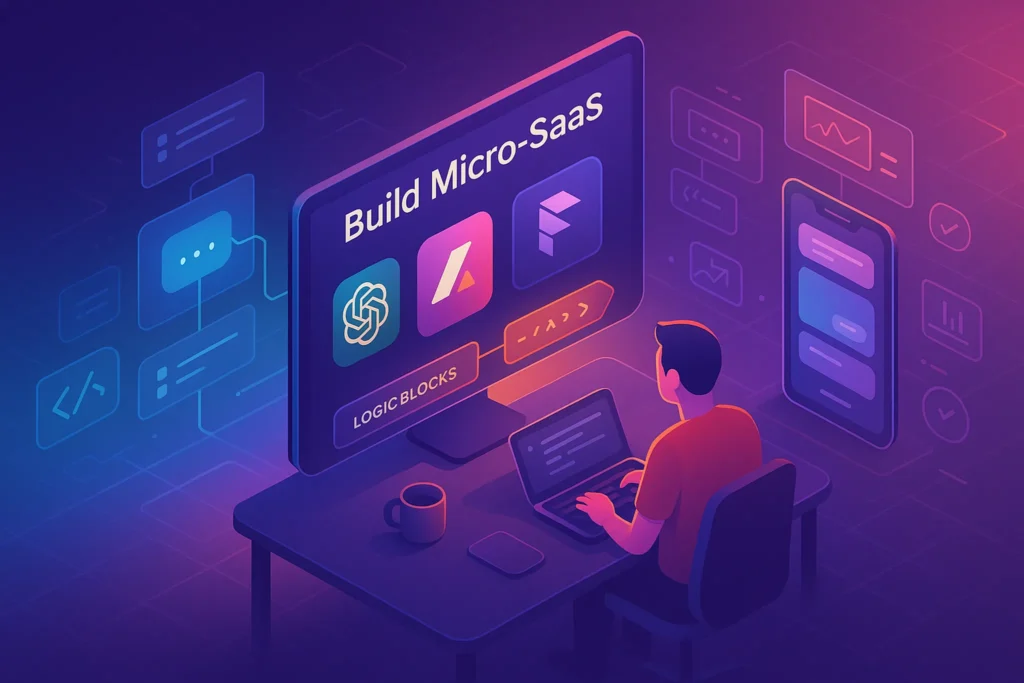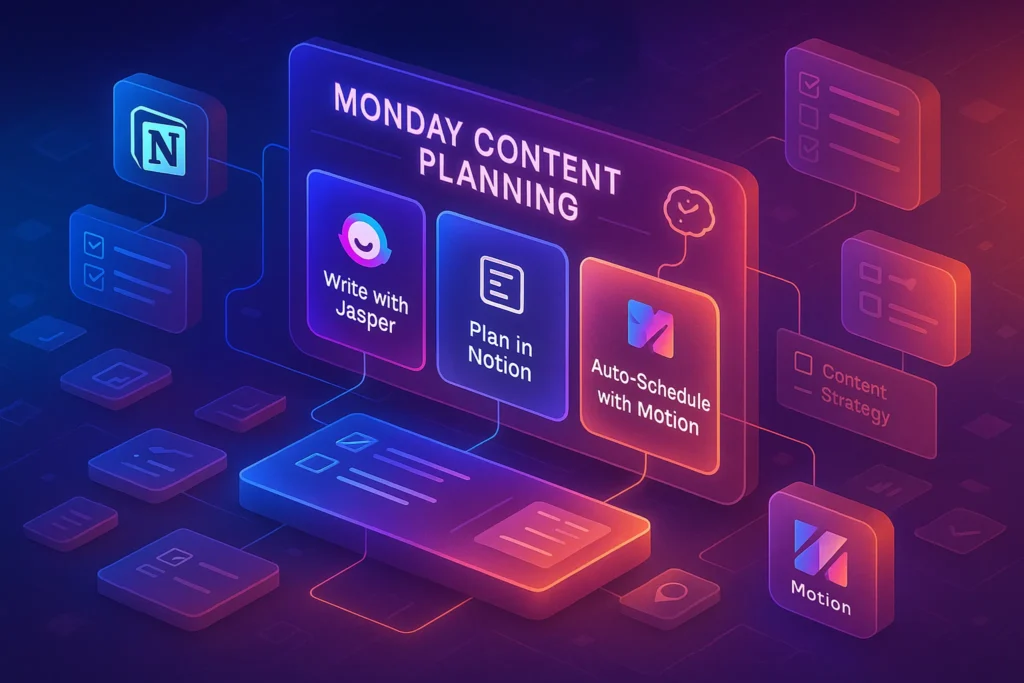🎯 Intro
Even the best writers can lose their way without a clear roadmap. That roadmap is the content brief—a structured outline that guides the piece from start to finish. In the past, creating a high-quality brief meant hours of manual keyword clustering, competitor analysis, and audience research. Today, AI has stepped in to revolutionize this step. Content brief generators are becoming the backbone of efficient content workflows in 2025, turning blank pages into clear, data-backed structures in minutes.
Unlike keyword research tools or general AI writing assistants, these platforms don’t aim to write the article for you. Instead, they give you a strategic starting point—an SEO-aligned, intent-focused brief that ensures writers hit the right notes. If you’ve ever explored Best AI Writer Tools for Digital Marketers or Ultimate Guide to Using ChatGPT for Keyword Research, think of content brief generators as the missing link between research and actual writing.
🔍 What is a Content Brief Generator?
A content brief generator is an AI-powered tool that transforms research inputs into structured outlines. Instead of manually digging through Google results, analyzing competitors, and clustering keywords, these tools use AI models to automate much of the groundwork.
It’s important to distinguish them from keyword tools and AI writing platforms. While keyword tools tell you what to target, and AI writers attempt to generate the text itself, brief generators sit in the middle. They take keywords, search intent, and competitive data to produce a blueprint for the content. That blueprint typically includes headings, subheadings, recommended keywords, intent alignment, and sometimes even suggested angles for differentiation.
In short, if keyword tools answer “what should we write about?” and AI writers try to answer “how should it sound?”, then brief generators answer “how should the piece be structured?”.
🛠️ Key Features of AI-Powered Brief Generators
Modern content brief tools have matured into full-stack pre-writing assistants. Key features usually include:
-
Keyword clustering & intent mapping. Instead of giving you a flat list of terms, they group queries by intent (informational, commercial, transactional) and suggest which sections should target which cluster.
-
Outline generation. Based on competitor analysis and SERP trends, the AI proposes H2 and H3 structures to ensure the article covers the right ground.
-
Gap analysis. Tools highlight what top-ranking competitors missed, helping you carve out unique angles and differentiate your content.
-
Audience insights. Some platforms suggest what the reader expects to see—whether data points, case studies, or FAQs—based on behavior patterns.
-
Integration. Many tools now plug directly into Google Docs, WordPress, or CMS platforms, streamlining workflows and avoiding copy-paste fatigue.
💡 Nerd Tip: Never rely blindly on AI-generated briefs. Always validate search intent manually—sometimes the nuance of a query doesn’t translate perfectly into machine clustering.
⚡ Best Tools in 2025
The space for content brief generation has exploded, but five platforms lead the charge in 2025:
-
Clearscope – Famous for its content optimization features, it also provides AI-driven outlines that align with semantic SEO requirements.
-
Surfer SEO – One of the most popular choices for SEO-focused teams, offering detailed SERP-based brief generation with keyword density guidance.
-
Frase.io – A powerful tool that combines AI brief generation with competitor gap analysis and content scoring.
-
SEMrush Content Outline Builder – Integrated with SEMrush’s keyword and SERP data, allowing briefs to tie directly into existing keyword campaigns.
-
Jasper Content Briefs – Jasper has expanded beyond writing to offer auto-generated briefs, complete with headings, key points, and tone suggestions.
Writers who previously felt lost at the blank page now have structured scaffolding. And when combined with Repurposing Content, briefs help ensure every piece is built for scalability across channels.
🚀 Workflow Example
Let’s walk through how a team might use a content brief generator in practice:
-
Start with a seed keyword. Enter a core phrase such as “AI-powered project management tools.”
-
Generate the outline. The tool produces a draft structure with H2/H3 headings, keyword clusters, and intent suggestions.
-
Check competitors. Run a quick analysis to see what competitors are covering and identify angles they missed (like case studies or ROI metrics).
-
Differentiate. Add unique insights, expert commentary, or data your competitors don’t have—this is where human creativity shines.
-
Assign or write. Hand the AI-powered brief to a writer or use it as the framework for your AI-assisted draft.
-
Optimize & publish. Refine for readability, SEO, and audience fit before pushing live.
This workflow doesn’t just save time; it ensures consistency across writers and scales with teams.
⚠️ Challenges & Solutions
Like any AI tool, content brief generators have limitations. Some outputs are too generic, simply mimicking what competitors already rank for. To fix this, always add a human editing layer that injects brand voice and unique angles.
Another issue is keyword stuffing. Some tools lean too heavily on keyword repetition, which risks penalties or clunky writing. The solution is to treat AI keyword density suggestions as guidelines, not rules.
Finally, language coverage can be a barrier. While English dominates, non-English briefs may lack nuance. Teams publishing multilingual content need to combine AI briefs with native editors to maintain accuracy and authenticity.
📈 ROI of Using Brief Generators
The ROI case is compelling. Teams using AI brief generators often report time savings of 50–70% in their pre-writing process. A task that once took two hours of manual SERP analysis can now be completed in 20 minutes.
For teams with multiple writers, brief generators ensure consistency—every article aligns with the same structural standards. This reduces rewrites, editing time, and misalignment across contributors.
SEO outcomes also improve. Brands using AI briefs often see stronger topical authority in their niche, because briefs encourage coverage of related subtopics competitors overlook. Combined with keyword research from Ultimate Guide to Using ChatGPT for Keyword Research and automation from 7 Emerging AI Marketing Tools You’ve Never Tried, content briefs deliver both efficiency and performance.
⚡ Don’t Start from a Blank Page
AI-powered content brief generators like Surfer, Frase, and Jasper help you skip the manual grind. Build outlines in minutes and give your writers clarity from day one.
Human vs AI Briefs – The Hybrid Role
AI excels at scanning competitor pages, clustering keywords, and spitting out a draft outline. Tools like Frase, Surfer SEO, or Clearscope can generate structured H2/H3 suggestions within minutes.
But here’s the reality: a content brief is not just a skeleton of headings. Human writers and editors still play a critical role:
-
Aligning tone and voice with the brand identity
-
Adding unique perspectives or case studies that AI misses
-
Cutting or merging redundant sections to create a smoother narrative
📌 Example: The AI might suggest seven headings for “Content Gap Analysis.” But an editor realizes two of them overlap, while another angle (case study) is missing. The best briefs are born from a hybrid workflow: AI speed + human creativity.
Impact on Team Workflow
AI brief generators don’t just save time—they streamline the entire editorial pipeline:
-
SEO Specialist: Feeds the target keyword → gets a data-backed brief.
-
Editor: Reviews, adds differentiation points, and adjusts brand tone.
-
Writer: Starts writing with clarity, skipping hours of scattered research.
-
Optimizer: Ensures final draft aligns with the original brief and search intent.
The benefits:
-
Fewer revisions → less back-and-forth between writer and editor.
-
Faster delivery → a post that used to take 2 weeks may now take 1 week.
-
Consistent quality → every writer follows the same framework.
Metrics & Measurement
A good content brief isn’t just “nice to have.” It’s measurable. The KPIs that reveal whether briefs are actually working include:
-
Revision Cycles: Reduced from 3–4 rounds to just 1 or 2.
-
Time-to-Write: Teams save 30–40% of the time spent drafting.
-
Time-to-Rank: Since briefs are based on search intent, pages often rank faster.
-
Consistency: Voice, structure, and quality stay uniform across multiple writers.
By treating briefs as a performance lever, teams can prove ROI and secure more budget for scaling content.
Integration with AI Writing & CMS
Modern content brief generators aren’t standalone tools anymore—they’re integrated hubs:
-
Surfer SEO → exports briefs directly into Google Docs.
-
Frase.io → pushes outlines into WordPress drafts.
-
Jasper → generates a brief and simultaneously drafts the first paragraphs.
This frictionless workflow reduces tool-switching and makes the process from research → outline → draft → publish smooth. Teams can shave hours off production just by leveraging these integrations.
Ethical / SEO Pitfalls
AI-generated briefs come with hidden risks if you use them blindly:
-
Content Homogenization: Everyone relying on the same AI outlines leads to lookalike content across the SERPs.
-
Keyword Stuffing: Some tools still overemphasize density and spammy suggestions.
-
Thin Content: Following AI briefs without human insight can produce shallow, generic posts.
🔑 Solution: Always add a “differentiation layer.” Include original research, quotes, or unique frameworks. Remember: AI helps you cover the basics, but originality is what wins both readers and Google.
Case Study Snippet
A mid-sized content agency reported:
Before AI briefs:
-
2–3 hours of manual competitor research per article
-
Repeated back-and-forth between writers and editors
-
About 10 posts published per month
After adopting AI briefs (Frase + Surfer SEO):
-
Research time dropped to 20–30 minutes
-
Writers received polished outlines → fewer revisions
-
Output doubled to ~20 posts per month
-
Organic traffic increased 40% within 6 months
This example shows how AI brief generators aren’t just “nice tools”—they can transform production speed, team efficiency, and traffic growth.
📬 Want More Smart AI Content Insights?
Join our free newsletter for weekly tips on AI content tools, no-code workflows, and future-ready marketing—curated by NerdChips for creators like you.
🔐 100% privacy. Just value. No fluff, no spam.
🧠 Nerd Verdict
Content brief generators in 2025 have matured into must-have tools for content teams. They don’t replace human creativity, but they eliminate the inefficiencies of starting from scratch.
For small teams, they compress research time into minutes. For enterprises, they guarantee structural consistency across hundreds of articles. The bottom line: briefs set the stage, and human insight steals the show. Writers who combine AI-powered briefs with original thought will always outperform those relying solely on automation.
❓ FAQ: Nerds Ask, We Answer
💬 Would You Bite?
The last time you stared at a blank page, how much faster could you have written if a ready-made brief was waiting for you?
Crafted by NerdChips for creators and teams who want their best ideas to travel the world.



